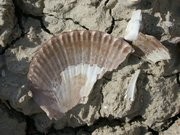Paleontology

The fossil flora and fauna of the Montalbano badlands delivers to the scientific community important information from a paleoecological, paleobiogeographical and paleoclimatical research perspective, as well as for taphonomic studies. Fossil species include benthic foraminifera, coccolithophores, molluscs, crabs, bryozoans, plant remains and “otoliths”. Otoliths are small calcareous aggregations that are part of the ear apparatus of teleostean fishes.
The presence of fossilized, totally intact crabs and sea urchins, whose spines are still clearly recognizable, provide evidence of life-position death organisms; their sudden death was due to mudflows in the sea that caused their suffocation and rapid burial into the sediment.

Scientific studies, carried out both on macro-and microfossils, allowed to reconstruct the paleoenvironments based on the known ecological preference of the species. These habitats range from the “bathyal” to those that were “near the coast”, that is from around 500-600 meters of sea depth to around 10 meters.
The distribution of certain fossil groups and the geochemical features of their mineralized skeletons allowed also to recognize and predict accurately the rise and fall of the sea level, due to climatic factors.
During the interglacial period, the increase in the global temperature caused the melting of the polar ice caps and thereby a rise in the sea level and its flooding onto the land masses. During the glacial phase, the opposite happened, and the decrease in the temperature led to the formation of additional ice around the polar caps and to a subsequent reduction of the sea levels.
Research on planktonic foraminifera allowed quite accurately to predict and reconstruct paleoclimatic curves. Since the distribution of these marine organisms is considerably affected by chemical and physical parameters (such as for instance, temperature change) their variation in taxonomic composition is a valid tool for the reconstruction of the past climate.


